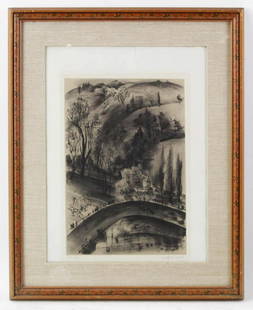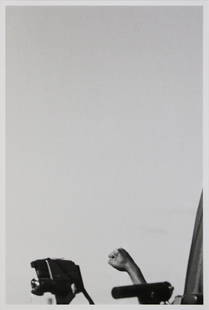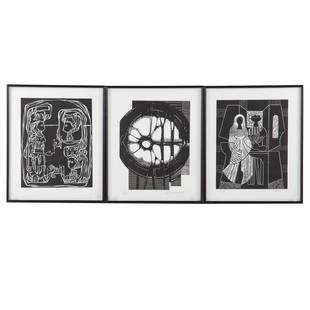
Adolf Dehn lithograph, Niagara Falls, dated 1931
Adolf Arthur Dehn Sale History
View Price Results for Adolf Arthur DehnRelated Prints & Multiples
More Items in Prints & Multiples
View MoreRecommended Art
View More










Item Details
Description
Adolf Dehn lithograph, Niagara Falls, signed by the artist and dated 1931.
Lithograph: 11" x 14 3/4"
Mat: 12 1/2" x 17 1/2"
Davids notes:Davids notes: This work came out of storage unit in Ossining NY, that belonged to Dr. Gregory Siskind. He inherited the lifetime collection of art of the artist Stella Drabkin and her husband Dr. David L. Drabkin. The collection is large and extensive, including art by Henry Moore, Rufino Tamayo, Lynn Ward, Adolf Dehn and others.
Adolf Dehn
(Source: Wiki) Adolf Dehn (22 November 1895 0 19 May 1968) was an American lithographer. Throughout his artistic career, Dehn participated in and helped define some important movements in American art, including Regionalism, Social Realism, and caricature. Two-time recipient of the Guggenheim Fellowship, he was known for both his technical skills and his high-spirited, droll depictions of human foibles.
Dehn was born in 1895 in Waterville, Minnesota. Dehn began creating artwork at the age of six and by the time of his death had created nearly 650 images.
After graduating as valedictorian from Waterville High School in 1914, he went to the Minneapolis School of Art, known today as the (Minneapolis College of Art and Design) where he met and became a close friend of Wanda Gag. Wanda was Dehn's first love and the two were: practically inseparable for the next five years (1916-21). In 1917 he and Gag were two of only a dozen students in the country to earn a scholarship to the Art Students League of New York. He was drafted to serve in World War I in 1918, but declared himself a conscientious objector and spent four months in a guardhouse detention camp in Spartanburg, SC and then worked for eight months as a painting teacher at an arm rehabilitation hospital in Asheville, NC. Later, Dehn returned to the Art Students League for another year of study and created his first lithograph, The Harvest.
In 1921 Dehns lithographs were featured in his first exhibition at Weyhe Gallery in New York City. From 1920 to 1921 in Manhattan, Dehn was connected to New Yorks politically left swinging activists. In 1921, he went to Europe. In Paris and Vienna he belonged to a group of expatriate intellectuals and artists, including Andree Ruellan, Gertrude Stein, and E.E. Cummings.
Dehn found living in Europe cheap and was able to embark on artist adventures of what some consider the glory years of the 20s. About his time in Europe Dehn stated: Life in Paris is simply glorious. Dehn supported himself through his time in Europe by providing light-hearted cartoons and scenic European landscapes to editors back in the U.S. A number of the caricatures he drew depicting the Roaring 20s, burlesque, opera houses, and the cafe scene appeared in such magazines as Vanity Fair. Dehn himself felt that his caricatures and cartoons were different from others because his motives were "never really political" but more focused on social commentary. The fame that Dehn achieved during his time in Europe, his illustrations appearing in many leftist publications such as The Liberator, The New Masses, and The Dial was noted by hometown paper The Minneapolis Journal in 1925. The publication described Dehn as "being born with a pitchfork in his mouth" while commenting on the worldly nature of Dehns drawings.
His favorite medium was lithography, and he alternated between spoofing high society and creating beautiful landscapes. Throughout his time in Europe, Dehn was in contact with many other notable intellectuals and artists of the time including recognizable figures such as Josephine Baker, Kurt Weill, and Leo Stein. It was in Paris that Dehn met his first wife, Mura Ziperovitch (Mura Dehn), a dancer who had left revolutionary Russia. Upon Dehns return to the U.S. the Chicago Tribunes Paris edition published a farewell to Dehn, stating "We are sorry to see that Adolf Dehn is going back to America," marking the impression his presence made among the inhabitants of Montparnasse.
In 1929 Dehn returned to New York with his wife. In New York, Dehn began to focus his art on depicting scenes of Manhattan, showcasing the skyline and views of the city from the Staten Island Ferry.[11] As the Great Depression had taken hold of the country, they were desperately poor, and their financial difficulties contributed to their ultimate divorce. In the 1930s, his work began to appear in magazines such as the The New Yorker and Vogue. During his period as a lithographer, his striking images of New York City, including Central Park, captured the essence of the Roaring 20s and the 1930s Depression era.
Beginning in 1930, Dehn made numerous trips back to his home in Minnesota, where he could live cheaply, and he executed a significant number of drawings and lithographs based on Midwest scenes. Dehn also summered on Martha's Vineyard, from 1933–1936, often in the company of Thomas Hart Benton, Jackson Pollock, Georges Schreiber, and others in the vicinity of Gay Head and Menemsha, and joined by his girlfriend at the time, Eileen Lake. In the early 1930s, Dehn established The Adolf Dehn Print Club and became a founding member of the Associated American Artists. Prints magazine selected Dehn as one of the 10 best printmakers in the United States in 1936.
He earned a Guggenheim Fellowship in 1939,[1] which allowed Dehn to travel to the western United States and to Mexico. In the early 40s, he worked as an instructor of etching and lithography at the Colorado Springs Fine Arts Center and received a citation from the U.S. treasury department for Distinguished Service Rendered in Behalf of War Savings Program.
Dehn started executing watercolors in late 1936, admitting he had "been afraid of color" in the first decades of his career.[13] Dehn rose to the top tier of American watercolorists in short order, seen in a feature article on Dehns work in watercolor in Life magazine (August, 1941) and a traveling show organized by the Museum of Modern Art, Four American Water Colorists (1943–44) in which eleven Dehn watercolors were joined with the works of Winslow Homer, John Singer Sargent, and Charles Burchfield. Dehns watercolors were described to have a: homely poetry with a modern sensitiveness. Water color painting and casein painting represented signature second and third arms of Dehns artistic output for the rest of his career.
In 1944, Dehn met Virginia Engleman, who was working in the Associated American Artists printshop. The couple married in 1947 and enjoyed an artistic collaboration for the rest of his life. In the 1940s, Dehn began to sell more lithographs and to teach other American artists lithography techniques. In 1947 Dehn joined the Society of American Graphic Artists exhibiting his lithograph, Lake in Central Park, in the 32nd Annual Exhibition for $5.00. Dehn published his first book titled Water Color Painting in 1945. As he became more widely recognized and financially successful, he was able to travel extensively. As well as visiting and painting Key West, and the southwestern region of the United States, he went to Venezuela, Cuba, Haiti, Afghanistan and other areas of the world. The wide range of subject matter found in his prints, drawings, and paintings reflects his travels. Dehn was awarded a second Guggenheim Fellowship in 1951.
In 1961, Dehn was elected as a full academician to the National Academy of Design and in 1965 he was elected as a member of the National Institute of Arts and Letters. Dehn visited Paris for the last time in 1967 where he worked at the Atelier Desjobert. He died on May 19, 1968. Adolf Dehn is remembered as a prolific artist of great range. His works are held in over 100 museums (including the National Gallery of Art, National Portrait Gallery, Metropolitan Museum, Museum of Modern Art, and Whitney Museum of American Art); over twenty-five museums hold extensive collections of Dehns output. Many prominent galleries represented Dehn as his fame grew, and posthumously, among them Harmon-Meek Gallery and Thomas French Fine Art.
Lithograph: 11" x 14 3/4"
Mat: 12 1/2" x 17 1/2"
Davids notes:Davids notes: This work came out of storage unit in Ossining NY, that belonged to Dr. Gregory Siskind. He inherited the lifetime collection of art of the artist Stella Drabkin and her husband Dr. David L. Drabkin. The collection is large and extensive, including art by Henry Moore, Rufino Tamayo, Lynn Ward, Adolf Dehn and others.
Adolf Dehn
(Source: Wiki) Adolf Dehn (22 November 1895 0 19 May 1968) was an American lithographer. Throughout his artistic career, Dehn participated in and helped define some important movements in American art, including Regionalism, Social Realism, and caricature. Two-time recipient of the Guggenheim Fellowship, he was known for both his technical skills and his high-spirited, droll depictions of human foibles.
Dehn was born in 1895 in Waterville, Minnesota. Dehn began creating artwork at the age of six and by the time of his death had created nearly 650 images.
After graduating as valedictorian from Waterville High School in 1914, he went to the Minneapolis School of Art, known today as the (Minneapolis College of Art and Design) where he met and became a close friend of Wanda Gag. Wanda was Dehn's first love and the two were: practically inseparable for the next five years (1916-21). In 1917 he and Gag were two of only a dozen students in the country to earn a scholarship to the Art Students League of New York. He was drafted to serve in World War I in 1918, but declared himself a conscientious objector and spent four months in a guardhouse detention camp in Spartanburg, SC and then worked for eight months as a painting teacher at an arm rehabilitation hospital in Asheville, NC. Later, Dehn returned to the Art Students League for another year of study and created his first lithograph, The Harvest.
In 1921 Dehns lithographs were featured in his first exhibition at Weyhe Gallery in New York City. From 1920 to 1921 in Manhattan, Dehn was connected to New Yorks politically left swinging activists. In 1921, he went to Europe. In Paris and Vienna he belonged to a group of expatriate intellectuals and artists, including Andree Ruellan, Gertrude Stein, and E.E. Cummings.
Dehn found living in Europe cheap and was able to embark on artist adventures of what some consider the glory years of the 20s. About his time in Europe Dehn stated: Life in Paris is simply glorious. Dehn supported himself through his time in Europe by providing light-hearted cartoons and scenic European landscapes to editors back in the U.S. A number of the caricatures he drew depicting the Roaring 20s, burlesque, opera houses, and the cafe scene appeared in such magazines as Vanity Fair. Dehn himself felt that his caricatures and cartoons were different from others because his motives were "never really political" but more focused on social commentary. The fame that Dehn achieved during his time in Europe, his illustrations appearing in many leftist publications such as The Liberator, The New Masses, and The Dial was noted by hometown paper The Minneapolis Journal in 1925. The publication described Dehn as "being born with a pitchfork in his mouth" while commenting on the worldly nature of Dehns drawings.
His favorite medium was lithography, and he alternated between spoofing high society and creating beautiful landscapes. Throughout his time in Europe, Dehn was in contact with many other notable intellectuals and artists of the time including recognizable figures such as Josephine Baker, Kurt Weill, and Leo Stein. It was in Paris that Dehn met his first wife, Mura Ziperovitch (Mura Dehn), a dancer who had left revolutionary Russia. Upon Dehns return to the U.S. the Chicago Tribunes Paris edition published a farewell to Dehn, stating "We are sorry to see that Adolf Dehn is going back to America," marking the impression his presence made among the inhabitants of Montparnasse.
In 1929 Dehn returned to New York with his wife. In New York, Dehn began to focus his art on depicting scenes of Manhattan, showcasing the skyline and views of the city from the Staten Island Ferry.[11] As the Great Depression had taken hold of the country, they were desperately poor, and their financial difficulties contributed to their ultimate divorce. In the 1930s, his work began to appear in magazines such as the The New Yorker and Vogue. During his period as a lithographer, his striking images of New York City, including Central Park, captured the essence of the Roaring 20s and the 1930s Depression era.
Beginning in 1930, Dehn made numerous trips back to his home in Minnesota, where he could live cheaply, and he executed a significant number of drawings and lithographs based on Midwest scenes. Dehn also summered on Martha's Vineyard, from 1933–1936, often in the company of Thomas Hart Benton, Jackson Pollock, Georges Schreiber, and others in the vicinity of Gay Head and Menemsha, and joined by his girlfriend at the time, Eileen Lake. In the early 1930s, Dehn established The Adolf Dehn Print Club and became a founding member of the Associated American Artists. Prints magazine selected Dehn as one of the 10 best printmakers in the United States in 1936.
He earned a Guggenheim Fellowship in 1939,[1] which allowed Dehn to travel to the western United States and to Mexico. In the early 40s, he worked as an instructor of etching and lithography at the Colorado Springs Fine Arts Center and received a citation from the U.S. treasury department for Distinguished Service Rendered in Behalf of War Savings Program.
Dehn started executing watercolors in late 1936, admitting he had "been afraid of color" in the first decades of his career.[13] Dehn rose to the top tier of American watercolorists in short order, seen in a feature article on Dehns work in watercolor in Life magazine (August, 1941) and a traveling show organized by the Museum of Modern Art, Four American Water Colorists (1943–44) in which eleven Dehn watercolors were joined with the works of Winslow Homer, John Singer Sargent, and Charles Burchfield. Dehns watercolors were described to have a: homely poetry with a modern sensitiveness. Water color painting and casein painting represented signature second and third arms of Dehns artistic output for the rest of his career.
In 1944, Dehn met Virginia Engleman, who was working in the Associated American Artists printshop. The couple married in 1947 and enjoyed an artistic collaboration for the rest of his life. In the 1940s, Dehn began to sell more lithographs and to teach other American artists lithography techniques. In 1947 Dehn joined the Society of American Graphic Artists exhibiting his lithograph, Lake in Central Park, in the 32nd Annual Exhibition for $5.00. Dehn published his first book titled Water Color Painting in 1945. As he became more widely recognized and financially successful, he was able to travel extensively. As well as visiting and painting Key West, and the southwestern region of the United States, he went to Venezuela, Cuba, Haiti, Afghanistan and other areas of the world. The wide range of subject matter found in his prints, drawings, and paintings reflects his travels. Dehn was awarded a second Guggenheim Fellowship in 1951.
In 1961, Dehn was elected as a full academician to the National Academy of Design and in 1965 he was elected as a member of the National Institute of Arts and Letters. Dehn visited Paris for the last time in 1967 where he worked at the Atelier Desjobert. He died on May 19, 1968. Adolf Dehn is remembered as a prolific artist of great range. His works are held in over 100 museums (including the National Gallery of Art, National Portrait Gallery, Metropolitan Museum, Museum of Modern Art, and Whitney Museum of American Art); over twenty-five museums hold extensive collections of Dehns output. Many prominent galleries represented Dehn as his fame grew, and posthumously, among them Harmon-Meek Gallery and Thomas French Fine Art.
Condition
Good condition overall
Buyer's Premium
- 25%
Adolf Dehn lithograph, Niagara Falls, dated 1931
Estimate $200 - $300
7 bidders are watching this item.
Shipping & Pickup Options
Item located in New York, NY, usSee Policy for Shipping
Local Pickup Available
Payment
Accepts seamless payments through LiveAuctioneers

TOP



































![Adolf DEHN - Print: Adolf Dehn (American, 1865-1968) print of figures on a rural farm landscape, signed in the print, dated '39. [Art: 9 1/2" H x 12 1/2" W; Frame: 15" H x 18" W].](https://p1.liveauctioneers.com/1221/326908/176418150_1_x.jpg?height=310&quality=70&version=1714157254)












































